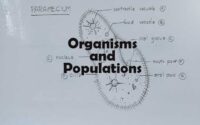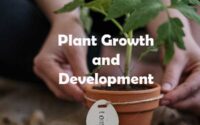Reproduction in Organisms
1. A true fruit is the one in which the fleshy part of the fruit is derived from-
A. Thalamus
B. Ovary
C. inflorescene axis
D. apocarpous gynoecium
2. A few plants exhibit unusual flowering phenomenon, which of them flower only once in their life time, generally after 50-100 years and produce large number of fruits?
A. Strobilanthus Kunthiana
B. Bamboo
C. Calistemon linearis
D. Cymbopogon reptocus
3. Choose the correct pair.
A. Coconut, Cucurbits-dioecious
B. Honeybee, Rotlfers—parthenogenesis
C. Ornithorhynchus, Whale-viviparity
D. Frog, Peacock—external fertilisation
4. Which one of the following shows isogamy with nonflagellated gametes-
A. Ectocarpus
B. Ulothrix
C. Spirogyra
D. Sargassum
5. Which one of the following is wrong about Chara.
A. Globule and nucule present on the same plant
B. Upper antheridium and lower oogonium
C. Globule is male reproductive structure
D. Upper oogonium and lower round antheridium
6. Planaria possesses high capacity of—
A. Regeneration
B. alternation of generations
C. bioluminescence
D. metamorphosis
7. Marchantia is considered heterothallic because it is
A. Heterogametic
B. Bisexual
C. Monoecious
D. dioecious
8. Gametogenesis refers to the process of-
A. fusion of two gametes
B. fusion of two gametangia
C. formation of two types of gametes
D. formation of male gametes only
9. Adventitious buds at the leaf notches help to propagate the plant of—
A. Potato
B. Agave
C. Bryophyllum
D. Cactus
10. Chromosome number in endosperm cell of plant a and in the root apical meristem cell of plant b together equal to chromosome number in shoot apical meristem cell of apple. Plants a and b respectively are—
A. Maize, Haplopappus
B. Rice, Potato
C. Rice, Haplopappus
D. Rice, Maize
11. The type of syngamy in Trichonympha is—
A. Hologamy
B. Anisogamy
C. Isogamy
D. Conjugation
12. In Albizzia, vegetative propagation takes place with the help of—
A. fasciculated tuberous roots
B. epiphyllous buds
C. subaerial branches
D. nonfleshy roots
13. Zygote is formed by the process of—
A. Isogamy
B. Anisogamy
C. Oogamy
D. Syngamy
14. The motile reproductive structure of algae and fungi, which directly give rise to new individuals are called—
A. Zygospores
B. Zoospores
C. Cysts
D. Conidia
15. Monoecious plant of Chara shows occurrence of—
A. Upper oogonium and lower antheridium on the same plant
B. Antheridiophore and archegoniophore on the same plant
C. Stamen and carpel on the same plant
D. Upper antheridium and lower oogonium on the same plant.
16. Meiosis occurs in—
A. Megaspore
B. Meiocyte
C. Conidia
D. Gemmule
17. Product of sexual reproduction generally generates-
A. new genetic combination leading to variation
B. large biomass
C. longer viability of seeds
D. prolonged dormancy
18. In which set of Organisms does external fertilization occur-
A. Echinodermata and mosses
B. Hemichordata and ferns
C. Amphibians and algae
D. Reptiles and gymnosperms
19. Vegetative propagation in water hyacinth takes place by—
A. Rhizome
B. Bulbil
C. leaf bud
D. offset
20. Which one is common to multicellular fungi, filamentous algae and protonema of mosses _____
A. Diplontic life cycle
B. Members of kingdom plantae
C. Multiplicaion by fragmentation
D. Mode of nutrition
21. Which one of the following is correctly matched?
A. Onion Bulb
B. Ginger-Sucker
C. Chlamydomonas—Conidia
D. Yeast—zoospores
22. Find out correct order of vegetative propagules of plants like potato, ginger, Agave, Bryophyllum and water hyacinth.
A. offset, bulbil, leafbud, rhizome and eyes
B. leaf bud, bulbil, offset, rhizome and eyes
C. eyes, rhizome, bulbil, leaf bud and offset
D. rhizome, bulbil, leaf bud, eyes and offset
23. Banana is vegetatively propagated by—
A. tubers
B. rhizomes
C. bulbs
D. suckers
24. Why is asexual reproduction sometimes disadvantageous-
A. It allows sedentary animals to produce offspring without mates
B. It allows animals to produce many offspring quickly
C. It saves times and energy of gamete formation
D. It produces genetically uniform population
25. Which one represents male gamete—
A. Antipodals
B. Synergids
C. Endosperm
D. Pollen grain
26. Bacteria, fungi and lower plants survive during adverse conditions by-—
A. suspended growth
B. migration
C. diapause
D. formation of thick-walled spores
27. Which is wrongly matched-
A. Agava-bulbils
B. PeniciIlium—conidia
C. Water Hyacinth—runner
D. Bryophyllum—leaf buds
28. Common between vegetative reproduction and apomixis is—
A. both applicable to dicots
B. both bypass flowering phase
C. both occur around the year
D. both produce progeny identical to parent.
29. A clone is—
A. A group of genetically similar Organisms produced as a result of asexual reproduction.
B. A group of genetically similar Organisms produced through sexual reproduction.
C. A group of genetically dissimilar Organisms produced as a result of asexual reproduction
D. A group of genetically dissimilar Organisms produced as a result of asexual reproduction.
30. Animals which possess cleiodoic eggs exhibit-
A. external fertilization and internal development
B. internal fertilization and internal development
C. internal fertilization and external development
D. external fertilization and external development
31. A haploid plant produces male or female gametes by—
A. binary fission
B. mitosis
C. meiosis
D. amitosis
32. Petiole is used in multiplication of—
A. Bignonia
B. Saintpaulia
C. Sansevieria
D. Pepromia
33. Regarding fertilization which among the following statements is incorrect—
A. It restores diploid condition in the zygote.
B. It activates egg both physiologically and metabolically.
C. Paternal and maternal sets contribute to the diploid number without causing any variation.
D. It determines the sex of the offspring.
34. Which among the following statements is correct to indicate the difference between sperm and egg—
A. Cytoplasm in sperm is more abudant than in egg.
B. Accessory membranes are absent in sperm but present in egg.
C. Nucleus is clear in sperm and very compact in egg.
D. Mitochondria from a sheath in egg and diffused in sperm.
35. Vegetative propagation in Pistia occurs by-
A. Stolon
B. Offset
C. Runner
D. sucker
36. Micropropagation is a technique for production of —
A. true to type plants
B. haploid plants
C. somatic hybrids
D. somaclonal plants
37. In grafting, stock is-
A. stem of desired variety
B. bud of desired variety
C. part of rooted plant
D. part to be grafted
38. Vegetative propagation in Mint occurs by—
A. Sucker
B. Runner
C. Offset
D. rhizome
39. Identify the correct statement-
A. Because of marked climatic variations, plants growing near the sea shore do not produced annual rings.
B. The age of the plant can be determined by its height.
C. Grafting is difficult in monocot plants as they have scattered vascular bundles.
D. Healing of damaged tissue is because of activity of sclerenchyma cells.
40. Which one of the following methods is commonly used to maintain the genetic traits of a given plant?
A. by propagating through seed germination
B. by propagating through vegetative multiplication
C. by generating hybrids through intergeneric pollination
D. by treating the seeds with gamma radiations
41. Life cycle of Ectocarpus and Fucas respectively are—
A. Haplontic, Diplontic
B. Diplonfic, Haplodiplontic
C. Haplodiplontic, Diplontic
D. Haplodiplontic, Haplontic
42. Zygotic meiosis is characteristic of :
A. Marchantia
B. Fucus
C. Funaria
D. ChIamydomonas
43. Which one of the following statements is not correct?
A. Offspring produced by the asexual reproduction are called clone.
B. Microscopic, motile, asexual reproductive structures are called zoospores.
C. In potato, banana and ginger, the plantlets arise from the internodes present in the modified stem.
D. Water hyacinth, growing in the standing water. drains oxygen from water that leads to the death of fishes.
44. Offsprings formed during sexual reproduction exhibits more variation than those formed by asexual method, because-
A. sexual reproduction is more complicated
B. genetic material comes from two different individuals.
C. genetic material comes from male parent
D. greater amount of DNA is involved.
45. Identify from the following group of animals, which exhibit oestrous cycle-
A. Monkey, Ape, Man and Elephant
B. Lion, Deer, Dog and Cow
C. Lion, Dog, Monkey and Ape
D. Cow, Monkey, Elephant and Ape
46. Which among these is not a post-fertilisation event?
A. Fruit formation
B. Gametogenesis
C. Seed formation
D. Embryogenesis
47. Flowers are unisexual in—
A. Pea
B. Cucumber
C. China Rose
D. Onion
48. Which of the following is not correctly matched-
A. Offset—Water Hyacinth
B. Rhizome—Banana
C. Binary fission—Sargassum
D. Conidia—PeniciIIium.
49. Stock and scion are used in—
A. Cutting
B. Grafting
C. Layering
D. micropropagation
50. Which of the following Organisms breeds only once in lifetime?
A. Bamboo
B. Oysters
C. Pelagic fishes
D. Birds
51. The chromosome number in meiocyte is 34. The Organisms could be—
A. ophioglossum
B. dog
C. onion
D. apple
52. Identify the wrong statement—
A. Plants produced vegetatively or asexually are called clones.
B. Organisms exhibiting external fertilization release a large number of gametes.
C. Development of embryo from fertilized female gamete is called parthenogenesis.
D. Conidia are formed in Alternaria.
53. Select the incorrect match out of the following-
A. Offset — Potato
B. Runner — Grass
C. Stolon — Jasmine
D. Sucker – Chrysanthemum
54. The type of reproduction adopted by an Organism depends on-
A. habitat and morphology of Organisms
B. morphology of an Organisms
C. morphology and physiology of an Organisms
D. oganism’s habitat, physiology and genetic make up.



